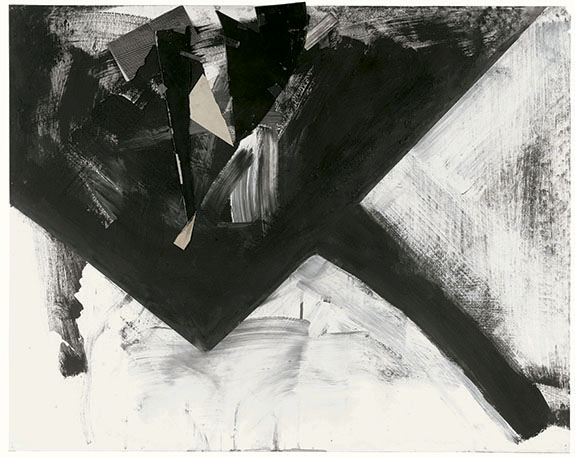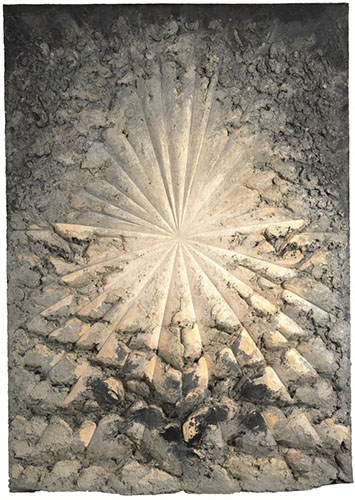 |
In the mid-50s, the critic Clement Greenberg opined that painting should be purged of gesture and emotion and be replaced with an affect-free style that emphasized flatness. Many artists heeded his command. Jay DeFeo, a San Francisco painter operating among Beat-era cohorts, blithely ignored it. Uninterested in the formalist orthodoxy then sweeping New York, she kept right on painting mega-thick abstract expressionist canvases, which she supplemented in later years with Cubist/Dadaist/Surrealist-rooted photo collages, assemblages, drawings and paintings whose visual themes reappeared in multiple series. That history might be passing her by cost her no sleep; she followed her own instincts.
Since the artist’s passing in 1989 at age 60, history has finally caught up with her in the form of a long-overdue retrospective, on view through Feb. 3 at SFMOMA. It doesn’t issue a referendum on Abstract Expressionism, something Greenberg would have surely liked; but it does stake out DeFeo’s unique place in it, situating her among Bay Area peers that included Bruce Conner, her then-husband Wally Hedrick, Jess, Wallace Berman, the poet Michael McClure, Joan Brown and many others. A romantic influenced as much by William Blake as by Franz Kline and the Renaissance art she viewed during a post-grad European trip, DeFeo carved sweeping lines from thick gobs of paint to summon the power of natural forces (mountains, waterfalls, landslides, cosmic rays), which served as platforms for the artist’s imaginary leaps into The Void.
.jpg) |
Her monumental canvases, which form the exhibition’s vital core, show the artist staring into and beyond the abyss of her own mortality. If such yearnings today feel overblown or histrionic, one need only look at the works in person to feel what she felt. Leading examples, including The Rose, are on view, along with other paintings, drawings, collages, photographs, sculptures and even sculpture-like kinetic jewelry, at which she excelled.
.jpg) |
In the show catalog the music critic Greil Marcus argues, on the basis of one such drawing of a broken record from the One O’Clock Jump series (named after the 1937 Count Basie hit), that jazz played a strong role in DeFeo’s visual thinking. If so, it’s one of only two pieces of evidence. (The other is Dr. Jazz.) No doubt, living in San Francisco, in a building filled with artists, DeFeo was surrounded by sound. (And clearly she clearly loved Basie.) But to align DeFeo’s art with swing feels slightly off. A more accurate musical analogy would be John Coltrane. The saxophonist imagined chords stacked one atop the other, and in his improvised lines he fleshed out every possible harmonic nuance, creating music that was dense and multilayered – just like DeFeo’s post-Rose photomechanical experiments. (The strongest examples on view here are the photo collages and paintings derived from a picture of the artist’s dental bridge.) Marcus also notes the fetish-like quality of DeFeo’s found-object constructions, and on this I’d agree: DeFeo’s visual obsessions give off serious mojo.
Whatever qualities and values one assigns to DeFeo as multimedia conjurer, the conversation always returns to The Rose. There’s no getting around it. By virtue of its weight (2,300 pounds), size (nearly 11 x 8 feet) and the years of solitary labor (1958-66) DeFeo spent creating it, The Rose long ago migrated into the realm of legend. If DeFeo had created nothing else, she and The Rose would be worthy of a shrine. SFMOMA, at least temporarily, has given her one by placing the piece in a separate room off the main exhibition space, good for quiet contemplation. The piece’s most prominent feature is a giant star burst whose lines converge, drawing your gaze inward to an infinity point whose center appears to glow like a distant star. The lines themselves measure several inches deep, and are set atop what looks like a pile of crumbling rocks, blurring the distinction between sculpture and painting. As such the imagery and the rigors of its creation merge, catapulting us into a transcendent realm.
 |
As the curator and critic Michael Duncan put it, “The Rose restores metaphor to its throne as the monarch of language and art, beckoning us to enter a realm inside the picture plane, deep within. The Rose is not simply a painted canvas. Like Moby Dick, it is a whopping metaphor that functions beyond language and image, a rhetorical and aesthetic flourish that challenges definition. Offering no closure but infinite quest, the sober, punch-drunk picture oscillates between the concave and the convex, between emanation and inhalation, between transcendence and abnegation. Amidst the debris of postwar culture, no other American work tackles the darkness with such persistent fervor.”
The same can be said of several other large-scale oil paintings DeFeo made in the ‘50s. Among them are the totemic/talismanic Dr. Jazz; the starburst-shaped The Jewel, with its bloody flesh-like surface “wounds”; The Veronica, whose intersecting Braque-like planes bring to mind an imminent landslide; and the overpowering Origin, which looks like a sea of gravestones being washed over a waterfall, one whose velocity and mass all but send spray into the gallery.
David;
I enjoyed reading this article, thanks very much. Saw the DeFeo exhibition (twice) and heading over there again before Feb. 3 for one more look.
The show is a bit sad in one regard. Many, (not all,) of Ms. DeFeo’s late large-scale paintings are simply not very unified between what we read as positive and negative shapes. They come off as extremely decorative; (that is, “pretty”, “swirly”, not flat-looking,) something like a velvet painting. They are not even close to being on a par with her best large works from the late ’50’s and early ’60’s, (i.e., Origin, The Veronica, etc.)
While I loved this show, (and love is not too strong of a word; she was a draughtsman after my own heart,) I cannot agree that Ms. DeFeo was “one of the greatest painters of the last century.” Imagine your list of great painters whose late-career work did not measure up to their best earlier efforts. Sadly, Ms. DeFeo would be on my list. Perhaps it could be partially attributed to her declining health?
Thanks again; I sincerely enjoy reading Square Cylinder.
Best,
Craig
Craig N. Smith